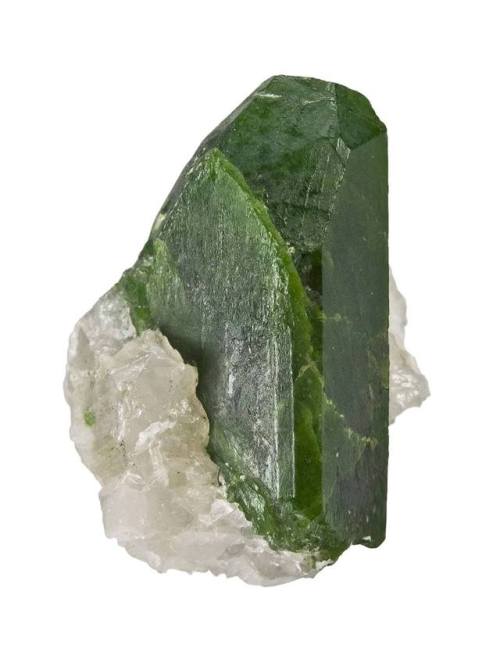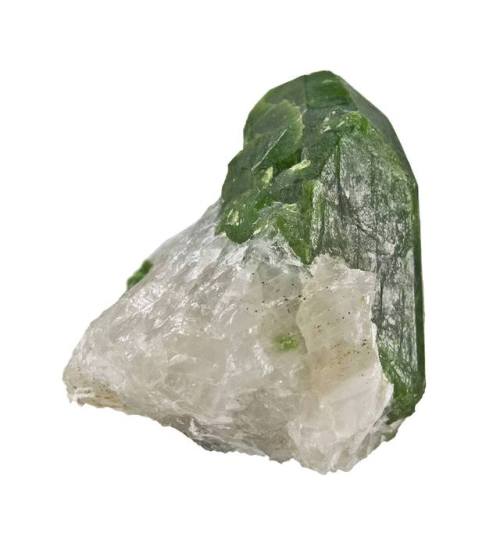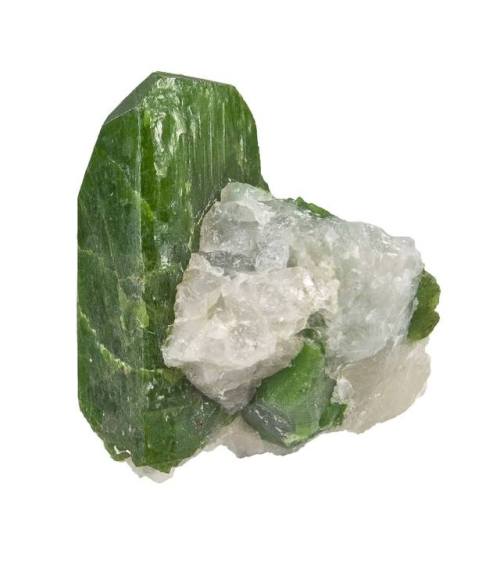Chrome DiopsideSharing the grassy green of emerald, Tsavorite garnet (on.fb.me/1ygBzM5) and c
Chrome DiopsideSharing the grassy green of emerald, Tsavorite garnet (http://on.fb.me/1ygBzM5) and chrome tourmaline (http://on.fb.me/1ixYQcu), this pyroxene group mineral has entered the mainstream gem market over the last years despite its relative softness (5.5 on Mohs scale) making it on the edge for jewellery use. As the name indicates, the gemmy version is that coloured by chromium (see http://on.fb.me/1gQbjaj for an explanation of how this happens), though four rayed star stones are also known and a variety of diopside rich rocks are used ornamentally.Diopside is a common mineral, born in the Earth’s fire, both igneous and metamorphic, and is a common constituent of parts of the mantle as well as erupting in low silica lavas such as basalt and andesite. It can also emerge on the surface after being carried up from the mantle in those strange blowout eruptions of volatile rich rocks known as kimberlites and lamprophyres (see http://on.fb.me/1GZOKfo). These rocks also bring up diamonds quickly enough that they do not change into graphite, the stable form of carbon at surface temperatures and pressures, and so along with certain compositions of pyrope garnet (also coloured by chromium), this lovely green beauty is one of the main diamond indicator minerals (see http://on.fb.me/1Dtt9WX for the fascinating story of how a pair of geologists followed them ‘up glacier’ in the Canadian Arctic to find a diamond mine, an old mineral exploration game named 'trail to lode prospecting’).Metamorphic diopside forms when magmas rise and stall into limestones, gradually freezing into granite. The heat and fluids given off as this happens bake and stew the surrounding rocks into a metamorphic aureole with concentric rings characterised by their varying mineral suites. Many odd minerals form in these skarns (as these rocks are known), and nearly all the gem and ornamental diopsides are amongst them.Chromian diopside occurs in Siberia, Pakistan, Tanzania, Austria, Burma, Canada, India, Sri Lanka and South Africa (amongst others), though the Russian material is on the whole the best, and certainly the most plentiful . Unlike emeralds it is rarely enhanced, though its softness makes it vulnerable to scratching, and I wouldn’t recommend it as a centre stone in a ring. It has also been mnis sold as Siberian Emerald. Most stones are under 2 carats, since the starting rough is often so dark that the tone of larger faceted gems becomes almost black (colour is described in terms of hue (green, red), tone (light or dark) and saturation (hiow deep it is, pink is an unsaturated red for example).This example sitting pretty on a marble matrix measures 3.1 x 2.9 x 2.5 cm and was mined in Finland.LozImage credit: Rob Lavinsky/iRocks.comhttp://geology.com/minerals/diopside.shtmlhttp://bit.ly/1RqmVyphttp://bit.ly/1SXCL73http://bit.ly/21jPZjbhttp://bit.ly/1LfURyzhttp://bit.ly/1QglYK1 -- source link
Tumblr Blog : the-earth-story.com
#diopside#chromium#chrome#mineral#mineralogy#crystal#mineralmonday



